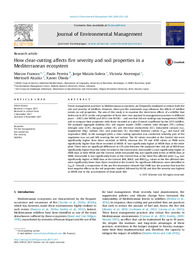Título :
How clear-cutting affects fire severity and soil properties in a
Mediterranean ecosystem |
Autor :
Francos, Marcos
Pereira, Paulo
Mataix Solera, Jorge
ARCENEGUI, VICTORIA 
Alcañiz, Meritxell
Úbeda, Xavier |
Departamento:
Departamentos de la UMH::Agroquímica y Medio Ambiente |
Fecha de publicación:
2017-11-10 |
URI :
http://hdl.handle.net/11000/7170 |
Resumen :
Forest management practices in Mediterranean ecosystems are frequently employed to reduce both the
risk and severity of wildfires. However, these pre-fire treatments may influence the effects of wildfire
events on soil properties. The aim of this study is to examine the short-term effects of a wildfire that
broke out in 2015 on the soil properties of three sites: two exposed to management practices in different
years e 2005 (site M05B) and 2015 (site M15B) e and one that did not undergo any management (NMB)
and to compare their properties with those recorded in a plot (Control) unaffected by the 2015 wildfire.
We analyzed aggregate stability (AS), soil organic matter (SOM) content, total nitrogen (TN), carbon/
nitrogen ratio (C/N), inorganic carbon (IC), pH, electrical conductivity (EC), extractable calcium (Ca),
magnesium (Mg), sodium (Na), and potassium (K), microbial biomass carbon (Cmic) and basal soil
respiration (BSR). In the managed plots, a clear-cutting operation was conducted, whereby part of the
vegetation was cut and left covering the soil surface. The AS values recorded at the Control site were
significantly higher than those recorded at M05B, whereas the TN and SOM values at NMB were
significantly higher than those recorded at M05B. IC was significantly higher at M05B than at the other
plots. There were no significant differences in C/N ratio between the analyzed sites. Soil pH at M05B was
significantly higher than the value recorded at the Control plot. Extractable Ca was significantly higher at
NMB than at both M05B and the Control, while extractable Mg was significantly lower at M05B than at
NMB. Extractable K was significantly lower at the Control than at the three fire-affected plots. Cmic was
significantly higher at NMB than at the Control. BSR, BSR/C and BSR/Cmic values at the fire-affected sites
were significantly lower than those recorded at the Control. No significant differences were identified in
Cmic/C. Overall, a comparison of the pre-fire treatments showed that NMB was the practice that had the
least negative effects on the soil properties studied, followed by M15B, and that fire severity was highest
at M05B due to the accumulation of dead plant fuel
|
Palabras clave/Materias:
Pre-fire management
Soil properties
Fire severity
Wildfire |
Área de conocimiento :
Ciencias del medio ambiente |
Tipo de documento :
info:eu-repo/semantics/article |
Derechos de acceso:
info:eu-repo/semantics/openAccess |
DOI :
https://doi.org/10.1016/j.jenvman.2017.11.011 |
Aparece en las colecciones:
Artículos Agroquímica y Medio Ambiente
|
 La licencia se describe como: Atribución-NonComercial-NoDerivada 4.0 Internacional.
La licencia se describe como: Atribución-NonComercial-NoDerivada 4.0 Internacional.
.png)
